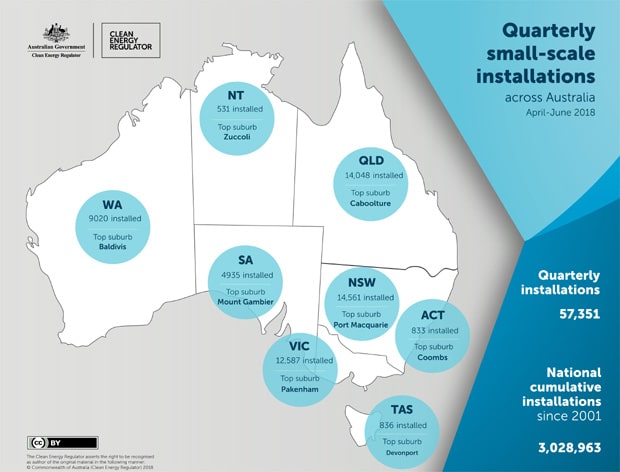Recent developments show that Victoria is leading the pack when it comes to state solar installation subsidies. The Andrews Government’s Solar Homes scheme announced in August is a glittering carrot dangled by a government facing a November election.
But when it comes to solar energy policy, let’s accept that the ends may have to justify the means; that is, if it takes an election to inspire political leadership to reduce emissions and energy prices, then we should be all for it.
What’s the alternative? Waiting for the federal government to build up another NEG, only to have it collapse like a house of cards at the last moment? The amount of effort spent on the National Energy Guarantee, notably by former Energy Minister Josh Frydenberg, brought us as close as we’ve come in recent years to a national energy policy.

But in the end the prospect of the NEG’s success meant Liberal Party fossil-fools were prepared to remove another leader to stop it. If the Victorian Government is playing election politics with its new Solar Homes solar installation subsidies scheme, that pales in comparison to the breathtaking political cynicism behind the demise of Malcolm Turnbull.
The Labor states were not entirely blameless either. They demanded the Coalition party room approve its own policy, which fast-tracked Turnbull’s demise. But the states got what they wanted, there was a party room consensus, and it seemed the NEG with all its flaws might put an end to the Energy Wars. Then factional politics got in the way, and Turnbull lost first his political nerve then his job.
State solar installation subsidies for Victorians
Stepping into this post-NEG energy policy vacuum, the Victorian Government is putting its money where its mouth is with its state solar installation subsidies, stating:
“A re-elected Andrews Labor Government will help Victorians save around $890 a year on their power bills with half price solar panels at no up-front cost.”
Then on Tuesday it dropped another bombshell, announcing its home battery scheme. Actually part of the Solar Homes state solar installation subsidies scheme, its announcement was separated from the initial Solar Homes announcement by 23 days, no doubt to maximise the impact of the government’s largesse on the voting public.
On the same day, the government announced new regulations that require property developers to take into account overshadowing on existing rooftop solar panels. The production of electricity on existing properties cannot be “unreasonably reduced” by future development. Heading into the election, there’s no doubting the colour of this true-blue Labor Government: green.
South Australia steps up on home batteries
Not to be completely outdone by Labor’s power politics, the Liberal Marshall Government in South Australia officially announced its $100 million Home Battery Scheme earlier this month. The upper limit of funding is $6,000, which represents almost half the cost of a Tesla Powerwall 2. The decision to fund batteries is a smart one given Australia’s relatively slow uptake of batteries compared to solar panels.
But there’s another reason for the states to emphasise batteries. Origin Energy boss Frank Calabria said in August that state governments should end the feed-in tariffs to rooftop solar owners. Calabria claims the tariffs – paid by retailers like Origin – are subsidised by customers without solar panels. “We believe the cost of those systems now no longer warrant a subsidy,” he said. “We believe it can stand on its own merits as a source of new energy.” It’s a strong vote of support for renewables, even if it’s more than a little self-serving.
Calabria is echoing recommendations from the ACCC. These include doing away with feed-in tariffs and cutting short the federal government’s small-scale technology certificate (STC) scheme. STCs are part of the Renewable Energy Target, a federal scheme started by the Howard Government in 2001. The scheme amounts to an installation subsidy on a solar power or wind energy system. The undoing of the Federal program may mean that state solar installation subsidies have to make up the slack.
On a level energy playing field, solar wins
The truth is that even without this support, solar is a viable option for cutting energy costs. Wilf Johnston, Managing Director of Flex Australia, Energy Matters’ parent company, believes that on a level playing field, with no subsidies for either coal or renewables, renewable energy is the winning choice.
Earlier this year, Johnston said Australia’s future energy mix will include more battery storage. It’s a prediction state governments on both sides of politics appear to be fulfilling.
So how do other states and territories compare?
In Queensland, you can get interest free loans for solar and storage if you receive Family Tax Benefit B. The Tasmanian Energy Efficiency Scheme (TEELS) runs until April 30, 2019, or until the $20 million cash pool is exhausted. The scheme offers residents a Westpac Credit Card with zero interest for 36 months up to a value of $10,000.
Elsewhere, things are less rosy. In Western Australia, the Premier said in July that all subsidies for solar energy should be stopped. In NSW, generous solar feed-in tariffs were ended in 2016. The ACT’s generous feed-in tariff scheme is now closed to new applicants. Meanwhile, the Northern Territory’s Smart Energy Grants offer up to $1,000 for new solar panel installations.
Should Australia follow California’s lead?
Subsidy or no subsidy, installing solar panels and a battery is a great way to cut electricity bills. Those states encouraging it deserve a pat on the back for envisioning a low emissions, low cost energy future.
But Australia as a nation is now without an energy policy. Can the energy market side-step a government tied down by political infighting and get on with business? Will new investment in renewables come without a clear incentive from the federal government? Can the states do what Canberra can’t?
Perhaps Australia should take a leaf out of California’s book. Announcing legislation that mandates a target of 100 per cent clean energy by 2045 this week, former California Senate Speaker Kevin de León said:
“Today sends a powerful message to the nation and the world. Regardless of who occupies the White House, California will always lead.”












































